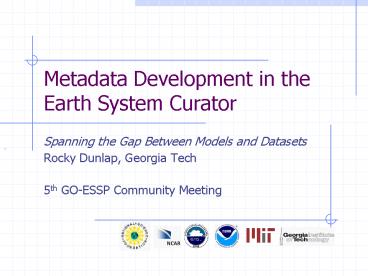Metadata Development in the Earth System Curator - PowerPoint PPT Presentation
1 / 19
Title:
Metadata Development in the Earth System Curator
Description:
Metadata Development in the Earth System Curator Spanning the Gap Between Models and Datasets Rocky Dunlap, Georgia Tech 5th GO-ESSP Community Meeting – PowerPoint PPT presentation
Number of Views:103
Avg rating:3.0/5.0
Title: Metadata Development in the Earth System Curator
1
Metadata Development in the Earth System Curator
- Spanning the Gap Between Models and Datasets
- Rocky Dunlap, Georgia Tech
- 5th GO-ESSP Community Meeting
2
Motivation
- Two primary products of the climate community
datasets and the models used to produce them
Models
Datasets
3
Motivation
- Many efforts in place to provide uniform access
to datasets - Additionally, groups are working to develop
frameworks for component exchanges and
interoperability - But, models and datasets are currently treated as
distinct and separate entities - Earth System Curators claim
- This gap is actually an artificial barrier that
inhibits access to resources and results
4
What is the Earth System Curator?
- The goal of the Earth System Curator project is
to provide a unified interface to both climate
models and their output data - This means a single portal will give you access
to both
Models
Datasets
5
Convergence of Models and Data
- ESC begins with a crucial insight
- the descriptors used for comprehensively
specifying a model configuration are also needed
for a scientifically useful description of the
model output data - This leads to the convergence of models and data
- There is a need for a common metadata formalism
to unify the treatment of models and data
6
Metadata
- Metadata is data about data
- Metadata that describes not only model outputs,
but the actual model configuration used to
produce the data - Provenance metadata a big part of this
Model Run
Model Metadata
Output
7
Use Case Scenario
- Jane Scientist has developed a malaria model
where mosquito breeding rates are modeled as a
function of rainfall and temperature - Because mosquitoes provide no feedback to the
climate model, she can run her model offline
from an existing climate dataset
8
Use Case Scenario
- Using Curator she discovers the needed dataset,
but finds out that the model used to produce it
systematically underestimates rainfall - Using the configuration description in Curator,
she is able to re-run the model with new
parameters to correct for the rainfall bias
9
Current Efforts
- Numerical Model Metadata (NMM)
- Earth System Modeling Framework (ESMF)
- Earth System Grid (ESG)
- GFDL Curator database
10
ESMF Metadata Structures
- Component
- Logical entity that models a particular physical
process or computational function - State
- Import/Export transport data to and from a
component - Field
- Physical quantity
- Grid
11
Metadata Needs
- What kinds of metadata do we need for Curator to
be a success? - Metadata to describe the complex component
hierarchies of current climate models, especially
components that are made up of multiple
sub-components - Metadata to describe applications that exist
across multiple repositories (e.g., labs) - Metadata to describe couplers as first class
citizens
12
Component Hierarchy
NASA GEOS-5 ESMF Application
parent/child
swappable components
13
Component Hierarchy
- Parent components need to identify their children
- children are created/invoked/destroyed by the
parent component - parent acts as a driver
- Allow for additional types of science components
beyond the typical atmosphere, ocean, sea ice,
etc
14
Multi-Repository Applications
- Components are highly decoupled and have
well-defined interfaces - This allows us to combine components from
different labs into one model - Components should be treated as standalone
entities - Components should be related to a particular
framework (PRISM, ESMF, etc.) - Configuration description stored separately from
general component description
15
Couplers
- Couplers are components that act as translators
between two components - e.g., regridding, averaging
- However, couplers may also have significant
science code inside, and therefore should be
treated as components - We still need to distinguish couplers from other
components
16
Deliverables
- Allow researchers to archive and query Earth
system models, experiments, model components, and
model output data - Perform technical compatibility checking
- How can we determine if two components will run
together? - What about scientific compatibility?
- Prototype auto-assembly of components to
facilitate model runs - Involves automatic code generation of simple
couplers
17
Broader Impacts
- Improve climate prediction for policy makers
- Facilitate Model Intercomparison Projects (MIPs)
by allowing fast setup and execution of
experiments using different model components - Encourage Curator-like activity in other domains
18
ESC Collaborators
- NSF Funded
- National Center for Atmospheric Research
- NOAA Geophysical Fluid Dynamics Laboratory
- MIT
- Georgia Tech
19
Thanks!
- Website http//www.cc.gatech.edu/projects/curator
/ - Questions?































